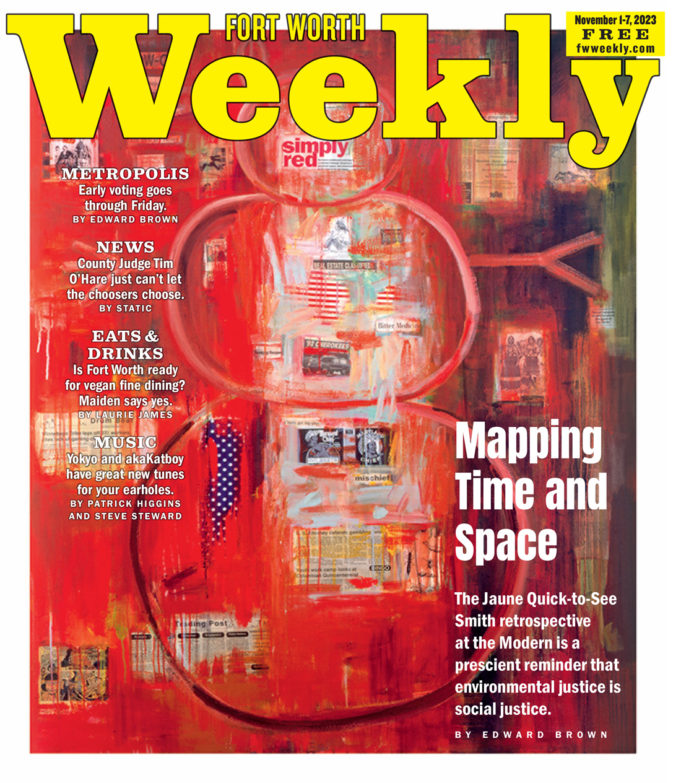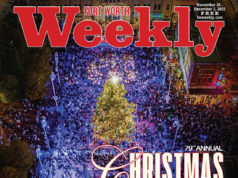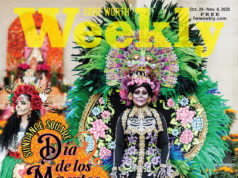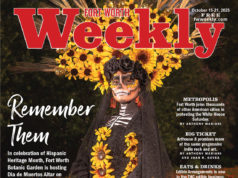“War Horse in Babylon” captures a horrifying scene. The large oil painting by Jaune Quick-to-See Smith centers on the gray silhouette of the animal surrounded by fiery, angry color fields. The flesh is pockmarked by bullet holes squirting blood as a floating heart drips black oil from above. A mound of skulls and bones crowd all the gore and destruction.
Like the rest of Memory Map, a career retrospective of Smith’s paintings and other works at the Modern Art Museum of Fort Worth, “War Horse in Babylon” pulsates with unease. If the aim is to capture this country’s worsening environmental and societal distress, Smith always achieves her goal. For 50 years, the artist, activist, curator, and educator has employed a combination of painting, prints, drawings, and sculpture to counter mainstream narratives about Native Americans like herself. The Salish and Kootenai citizen refers to her pieces as “memory maps.”
“Homeland” is an actual map of the United States which draws the viewer to the upper-left portion of the painting where white lines radiate outward from an area within Montana — Smith’s birthplace — with alternating circles growing as they reverberate across the land. The spaces between the lines are alternatingly colored with bright pastels, lighting up the contiguous states in yellows, reds, and blues. The effect is one of jubilation and a reminder that Native Americans continue to add to the beauty of this country’s culture.
Through her work, Smith is unapologetically critical of Western consumerism and misguided nationalism. In “McFlag,” she uses a sprawling Old Glory to capture our love of all things large. Newspaper clippings reading “Land of the Giants” and “Big D” meld into the red horizontal lines. To emphasize her point, Smith places two speakers on the top corners of the banner, likely signifying our nation’s penchant for blaring our supposed greatness across the country and the globe.
“The Vanishing American” is one of Smith’s more abstract works here, but the message is clear. Overlapping red squares fill the center of the oil painting along with smatterings of newspaper clippings and a crossword puzzle. Hovering above the red-hued visual cacophony are white silhouettes of human heads, symbolizing Native Americans who see all but remain blotted out by the dense and dizzying scene beneath.
Several sculptures round out the exhibit. “Indian Madonna Enthroned” is a life-size model of a human-animal hybrid, likely signifying the interconnectedness of people and wildlife. The head has a grandmotherly countenance, given the body’s seated position and large red shroud around her. Her hands are feathers, and they hold the book God Is Red: A Native View of Religion. The title is all that is needed to frame the work as a reminder that rich spiritual beliefs guided the people of this country long before the first white conquerors arrived.
Throughout Memory Map, Smith explores a wide range of themes — all through the lens of her Native American heritage — but her most resonant motif deals with environmental justice and the implications for our consumer-driven economy. Understanding America’s history of allowing corporations to spew deadly chemicals into our water, ground, and air requires discussions about systemic racism, and that is a conversation Fort Worthians are just beginning to have. Residents of Echo Heights, the predominantly minority community in southeast Fort Worth, recently rallied downtown to bring attention to decades of industrial construction that residents allege have led to serious health problems and premature deaths (“ Justice Advocates Blame Systemic Racism for Pollution in Southeast Fort Worth,” Oct. 7).
Smith’s “maps” are as culturally and politically relevant as ever. These guides leave viewers free to chart their own pathways through her unsettling reflections on American consumerism and culture.
Memory Map by Jaune Quick-to-See Smith
Thru Sun, Jan 21, at the Modern Art Museum of Fort Worth, 3200 Darnell St, FW. $10-16. 817-738-9215.












